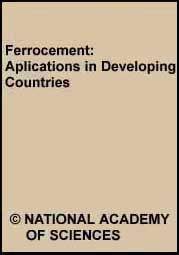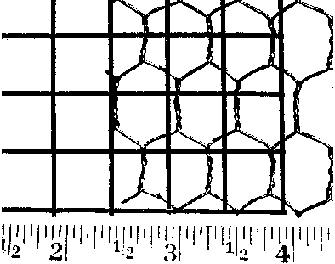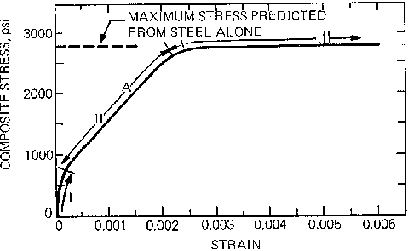
Ferrocement Materials Technology[edit | edit source]
A working definition of ferrocement is "a thin shell of highly reinforced portland cement mortar." Generally, ferrocement shells range from 1/2 inch to 2 inches in thickness, and the reinforcement consists of layers of steel mesh, usually with steel reinforcing bars sandwiched midway between. The resulting shell or panel of mesh is impregnated with a very rich (high ratio of cement to sand) portland cement mortar. (Other hydraulic cements may also be used.)
Specifications of ferrocement technology range widely according to use-from oceangoing vessels in which human lives are totally dependent on the material, to small, expendable household items. Although this chapter deals with ferrocement materials science in general, in practice the quality of the ferrocement used must be matched with the end use of the product.
REINFORCING MESH
Many different kinds of reinforcing mesh will produce successful ferrocement structures. (See Figures 16, 17.) A general requirement is flexibility. Shapes with tight curves need more flexible meshes. Chicken wire, the cheapest and easiest to use, is adequate for the structural requirements of most boats in developing countries and for all uses on land. It is not the most recommended mesh for high-performance structures, such as deep-water marine hulls.
The wire mesh could be woven on site from coils of straight wire, giving a local engineer greater opportunity to adapt the mesh size and wire diameter to any given job. Because wire coils are less bulky than mesh, this method might also save considerably on transportation costs (both ocean shipping and internal trucking costs). With less wire surface exposed to air, this method may, under corrosive tropical conditions, reduce deterioration during storage. A simple handloom could be adapted for weaving the wire into mesh.
For most purposes, the mesh need not be welded. Nongalvanized wire is excellent, though it will rust if stored in the open too long. Standard galvanized meshes (galvanized after weaving) are adequate.
Figure 17. Types of reinforcing mesh commonly used for ferrocement (R.B. Williamson, University of California, Berkeley)
CEMENT, SAND, AND WATER
The quality of cement used is not too critical. Ordinary Type 1 or 2 portland cement is adequate; grades for more specific purposes are unnecessary even for boatbuilding. Grading the sand is seldom important, except to improve mortar workability. Current experience indicates that volcanic sands and beach sands are adequate, but sand should not have an excess of fine particles. Experiments need to be made in using coral sand as a substitute for regular sand, which is not readily available in some areas. Organic debris and silt that will not bond to the mortar reduce the strength of the ferrocement and should be washed out. Water containing these impurities should also be filtered and purified; otherwise, water quality is not critical in general practice.
CONSTRUCTION
The three major problem areas in ferrocement construction are mortar mixing, mortar application, and curing. The mortar must be dense and compact. A trained supervisor can teach the mixer operator to judge mortar quality from the way it tumbles or rolls off the mixer blades. A general mixis 1 part cement, 2 parts sand. Water is added to give the required pastelike consistency (roughly 0.4 parts water by weight). A horizontal, paddle-bladed mixer is recommended for highest-quality mixing; it is critical for deep-water boats. For land uses, experience shows that hand-mixing is also satisfactory. Determining the cement-to-water ratio can be done with adequate accuracy by observing the mortar's consistency. Sand normally does not have a fixed moisture content; even in the same sandpile, the bottom layers tend to be more wet than the upper ones.
Fingers and trowels are used for mortar placement in the mesh structure. Mortar guns are not recommended because the heavier parts of the mortar (i.e., sand) tend to separate out. A certain amount of vibration helps to produce complete mortar penetration of the mesh and assure good compaction. An orbital sander (a simple power tool used widely in woodworking) with a metal plate substituted for the sandpaper pad has been found to provide the correct amount of vibration; the vibration is localized, so already-placed mortar is not shaken out of the mesh. It is also possible to create enough vibration by using a piece of wood with a handle attached, though this not recommended for building deep-water boats.
Finally, certain conditions for adequately curing the mortar are essential. The warmth and humidity of most tropical regions is conducive to the rapid curing of ferrocement, but ferrocement must not be exposed to excessive drying action of the elements. It should be kept moist at least 7 days and protected from the sun and wind, both of which reduce the concrete's strength by drying out surface moisture.
NOTE FOR ARCHITECTS AND ENGINEERS
As in the case of conventional reinforced concrete, the mechanical properties of ferrocement depend to a large extent on the properties of the cementitious matrix and the reinforcing steel. The apparent tensile properties of ferrocement represent a significant departure from that of ordinary reinforced concrete in that the dispersed reinforcement changes the observed cracking pattern. At a microscopic level the cementitious matrix is responding in the same way, but at the macroscopic level the first tension cracks generally appear at stress levels higher than for unreinforced mortar.
The setting of portland cement is the basic reaction in the fabrication of ferrocement. This setting process is identical to that of hardening conventional concrete, but special precautions must be taken if high levels of performance are expected. To produce an impermeable thin shell, for example, the mortar must have a low water-to-cement ratio. A proper moist-cure period is also imperative. Both of these ideals are readily appreciated by engineers and architects, but it may take special attention to achieve them in the field.
Figure 20. The three stages of typical stress-strain curve for ferrocement (Walkus, I.R. [Lodz Technical Univ., Poland], and T.G. Kowalsky [Hong Kong Univ.], "Ferrocement: A survey." Concrete [London]. Vol. 5, No. 1, Feb. 1971)
Figure 20 shows a typical stress-strain curve for ferrocement. In stage I the material behaves in a linearly elastic manner with both the reinforcement and the matrix deforming elastically. Then, as the load increases, the cementitious matrix cracks, and stage II begins where there is a change of slope in the stress-strain curve. It has been shown that the stress at the first crack can be increased by increasing the surface area of the steel exposed to the cement, by decreasing the diameter of the wire, by increasing the volume of reinforcement. These cracks are very fine and can be seen only by special lighting effects or microscopic investigation. For most purposes, the materials are unchanged by loading into this region, which constitutes ferrocement's practical working limit. Finally, stage III corresponds to the latter stages of deformation where the full load is being carried by the reinforcement. The stress limit of stage III can be predicted by considering the maximum load-carrying capacity of the steel reinforcement alone.
To put the mechanical properties into perspective, it is important to keep in mind that there is a transition from the characteristic behavior of ferrocement to that of conventional reinforced concrete and that much of the use of ferrocement in developing countries probably will fall on or near this transition. One of the important objectives in the future development of ferrocement will be a rational design system to cover the response of the structure to normal conditions, as well as the ultimate behavior of the structure. Engineering research is needed in this area.
The influence of the water-cement ratio on porosity has a great effect on the shrinkage, strength, and permeability of the final product. However, the practical upper limit of water-cement ratio for ferrocement depends on the acceptable value of permeability, since it is clear from Figure 21 that ferrocement made from mortar with a water-cement ratio of more than about 0.6 has a very high permeability.
Figure 21. Relationship between permeability and water-to-cement ratio (weight basis) for mature portland cement pastes (cement hydrated 93%). (R.B. Williamson, University of California, Berkeley)
The primary requirement for making waterproof mortar is tight control of the water/cement ratio, with the workability obtained by the gradation and quantity of sand as well as by the optional use of certain admixtures. This is also the prescription for making high-quality conventional concrete. Ferrocement is not as forgiving of careless practices as conventional concrete, and in the field it demands new degrees of control, compared to the simplicity of poured-concrete techniques.
Applying the mortar and ensuring that it penetrates the layers of mesh without leaving air pockets-a problem in ferrocement construction-is a particularly severe problem in boatbuilding.
Because ferrocement reinforcing has a somewhat different purpose from that of conventional reinforced concrete, these two considerations apply:
- Adequate cover to protect the steel from corrosion is necessary because in almost every application of ferrocement, the durability and resistance to environmental effects depend on the thin mortar cover over the steel mesh and its ability to protect the easily corroded steel mesh.
- It is desirable to have the mesh as near the surfaces as possible.
In a thin shell of ferrocement these considerations conflict; therefore, it is necessary to use a mesh of high-specific surface area (small-diameter wires) in the outer layers, and to use the lowest possible water-cement ratio to achieve the lowest permeability and greatest protection from reinforcement corrosion.
NOTE. Seawater places extra demands on ferrocement. Boats for marine use must be plastered with a cement resistant to sulfate attack. The surface should also be coated with paint or another sealant to further decrease saltwater penetration.


